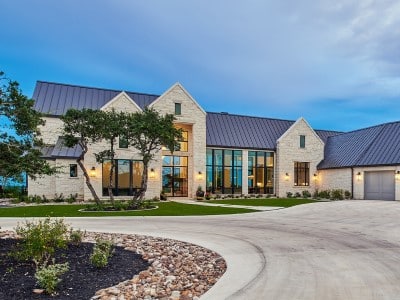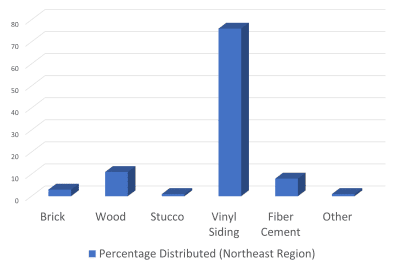Stucco was the most common principal exterior material on new single-family homes started in 2021 (27%), followed by vinyl siding (26%), fiber cement siding (such as Hardiplank or Hardiboard (22%), brick or brick veneer (19 percent). That is according to the data from the Census Bureau’s Survey of Construction (SOC).
Smaller shares of single-family homes started last year had wood or wood products (4%) and stone, rock, or other stone materials (1%) as the principal exterior wall material.

Vinyl siding reigned supreme from 1994, when it beat out wood as the #1 choice, through 2018.
Brick was the top dog up until 1975 when wood became the most popular siding material. However, brick has remained steady in the high teens and low twenty percent range from 1986 until today.
Stucco, though, has been on a steady increase since 2010, with 17% distributed to its 27% today.
There are many American house styles that use stucco for the exterior.
Some examples include the Spanish style, the Italianate style, and the Mission style. Each of these styles has unique features, which can be used to create very different looks. Let’s take a closer look at each one.`
The Spanish style is characterized by its red tile roofs, stucco walls, and arched doorways and windows. This style is very popular in the southwestern United States, where the climate is warm and dry, which is supported by the SOC, reporting stucco at 53% distributed and vinyl siding at 4% in the “West” region.
If you want to create a Spanish-style home, you’ll need to use materials that can withstand the heat, the sun, and the fires. Clay or concrete tiles are a good choice for the roof, and stucco is a common wall material. You’ll also want to use arched doorways and windows to create the characteristic look.

In the pacific northwest.
Many homeowners have chosen siding that reflects the region’s natural beauty. Wood siding, particularly cedar, has been a popular choice in this part of the country, as it offers a warm and inviting look. But if it’s built in the west and it’s not stucco, it’s fiber cement, according to the SOC.
Fiber cement is a material made of cement, sand, and cellulose fibers. It is often used as a substitute for siding material because it is durable, weather-resistant, and easy to install. Fiber cement can be smooth or have a wood grain profile, be painted or stained any color, and it doesn’t rot or decay like wood siding.

In the south.
Brick has been the dominant veneer for as long as the Census Bureau has compiled the data (almost 40 years). From what we’re seeing from the American Residential Design Awards winners, the Texas hill country style is gaining much traction as a design trend.
When most people think of Texas, they imagine vast expanses of rolling hills and prairies. For those who want to bring a bit of that beautiful landscape into their home, the Texas hill country style is the perfect option. This style combines traditional features with a rustic flair, resulting in a warm and inviting space.
The most important element of the Texas hill country style is stone, sometimes combined with stucco. This material is used extensively in both the exterior and interior of the home. On the exterior, natural stone siding is used to create a beautiful and unique façade. In addition to stone siding, wood and metal are popular choices for detailing. Stone gives the home a warm and inviting feel while also providing excellent protection from the elements.

In the Midwest.
In 2021 the use of wood as an exterior cladding was its greatest in the midwest at 17%. But wood is still a second choice to Vinyl Siding (60%). As an alternative, fiber cement is slowly becoming more popular. In 1974, one in four houses were finished with brick. Now it’s less than one in ten. Which is unfortunate. The Georgian style homes with painted brick, predominant in the midwest, are such beautiful homes.
In the northeast.
Colonial architecture has maintained popularity most prominently in the northeast, especially from Maine to Virginia. This most likely explains why three out of four houses are sided with Vinyl. It’s been that way since 1992. Before that, wood.
Horizontal siding is most commonly used in vernacular housing styles. Therefore, vinyl siding is a popular choice for horizontal siding due to its low maintenance and durability. Other choices for horizontal siding include wood, aluminum, and fiber cement siding, which is gaining traction in all regions as a wood alternative.

The Vinyl Siding Institute (VSI) offers a number of books that provide inspiration and insight. Designing Style: A Guide to Designing with Vinyl Siding is a guide on designing with vinyl siding that was developed in collaboration with experienced architects, designers, builders, and vinyl siding manufacturers.
Architectural Polymers: Best Practices For Architectural Specification, another book offered by VSI, is a detailed resource guide for understanding best practices for the design and installation of architectural polymers.
At the end of the day, there are many different types of siding available on the market, each with its own set of pros and cons. Much different than a half-century ago when almost everything was wood and brick, stucco, vinyl siding, brick, and fiber cement are now nearly used equally overall as a country.
The important thing is to consider the climate in which the house is located, as well as what is predominant for the style when choosing a home’s veneer.
